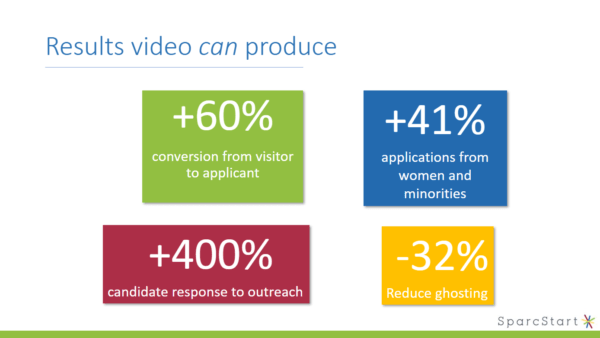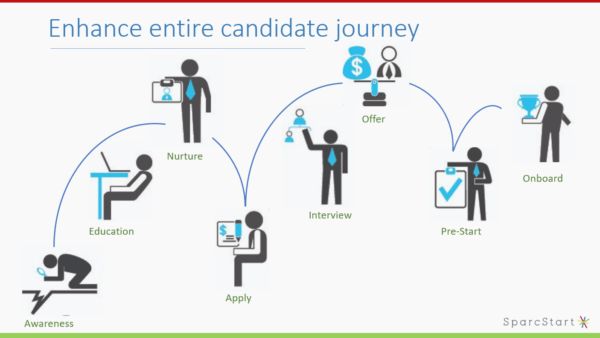This month members from the SparcStart team traveled to Lisbon to take part in World Employer Branding Day 2022. Our CEO Maury Hanigan hosted a workshop titled “Building an Authentic EVP Video Library for Long-Term Impact”. Below is the write up of that webinar that we would like to share so that those who were not able to attend the great event can gain insights into how to build your own video library that enhances and reflects your EVP.

We all understand that video is powerful at engaging and connecting with candidates. Video is being used for attraction, nurturing, DEI, campus, onboarding, internal mobility and more. But where do you begin when you are looking to build a coherent and authentic EVP video library at scale? First, take a look at this. It is one of our favorite videos and playfully points out the issues with the all-too-common generic recruiting video.
It’s okay if you are reading this now and thinking to yourself “Oh no, we have a video just like that on our career site,” most companies do and videos like this are a good starting point for building your library. Unfortunately, these videos are almost indistinguishable for candidates as they are researching various companies. Recruiting videos like this are not going to move the needle on getting candidates more familiar with your company and what it is actually like to work for you compared to your competitors; and ultimately drive them to apply. So, what kind of videos should you be making? You know video is crucial in communicating your authentic EVP and connecting with candidates but jumping into video creation can seem like a very daunting task. Where do you begin with deciding when to create videos with the right message and get them in front of the right audience? Let’s start with when to make a video. The short answer is throughout the entirety of the candidate journey, from the awareness stage all the way through to onboarding. This is especially true when addressing weak points in your candidate attraction, whether it is a high ghosting rate or low apply rates stemming from candidates not knowing enough about your company. Each stage should be treated differently in terms of the content you are showing and actual length of the videos. For example, candidates in the awareness stage are more likely to watch a shorter video that highlights your authentic EVP. Someone who is onboarding will be more willing to watch a 10-minute video covering let’s say the payroll system.

When potential candidates are in the awareness, education and nurture stages, they want to see specific content that is tailored to the roles and locations that interest them. Additionally, they want to see videos discussing the questions that they have. This could include information on career development opportunities, DEI initiatives, or company culture etc. For candidates that are going through the interview and offer stages, sending short and personalized videos from individuals who will be interviewing them can go a long way in keeping the candidate engaged. They will feel a personal connection to the company and other employees. Utilizing this tactic has been known to reduce ghosting rates significantly. Now, let’s talk about where to share these videos. A recent study done by CareerBuilder found that 92.5% of visitors to corporate career sites go directly to a job posting page without going through the home page or other ‘about us’ pages, the typical spots where companies put recruiting videos. Additionally, the study found that only 1.5% of visitors watch the corporate videos hosted on the career site home page.
So how do you get your videos seen? You need to share the videos where the candidates are already looking. Based on the CareerBuilder study, embedding video into the job descriptions, opposed to home page of the career site, is a great way to get candidates to see your content, especially if it’s a video specific to the role filmed by the hiring manager.
Beyond this, your candidates are on social media. They are spending hours scrolling through the likes of Facebook, Twitter, and LinkedIn. And if they are deeper into the candidate journey, they are communicating with you through email. These are all the places where you need to share your employer branding video in order to get in front of candidates and show them what makes your company and opportunities unique. Going even further, you can add to the reach of this content if it’s shared by employees on their social media feeds. Each employee is most likely connected to a large group of people who are in similar fields, i.e. a lot of engineers are connected to other engineers. If you can have the employees share on their socials you are not only getting in front of more candidates, but more high-quality candidates too.
 Loading...
Loading...
Now you have a general idea of how to get the most out of video content, let’s shift focus back to your specific case by going through an exercise. List out your three biggest candidate challenges at the moment. Then think about each issue and what information you can share with candidates that would strengthen those weak points. Next, think about who the best person is to deliver this information to candidates. Is it the hiring manager? Or is it a VP or even the CEO? Then write down how you would deliver this information to candidates. Remember to analyze where your candidates are at this specific stage in their journey. Lastly, write down how you would measure the results. Will you be looking at short term markers like watches and watch rates, or something more long term like number of applications for a role?
Now take this form and make it into a spreadsheet with columns for functions and locations. Identify the pressing challenges that your recruiters are facing and use video to provide clear and compelling solutions. You can also check out our additional resources below to help you on your way to building a powerful, results-producing video library.
 Loading...
Loading...
Jake Papa is a product manager and client success lead for SparcStart and can be reached at jake@sparcstart.com.
